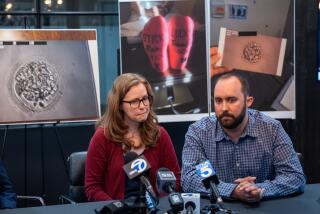Computer Chip Workers Risk Miscarriages
- Share via
SACRAMENTO — In the most comprehensive study to date of reproductive hazards in the workplace, UC Davis researchers found that women who work in fabrication areas of computer chip plants are 40% more likely to suffer miscarriages than other women working in the semiconductor industry.
The four-year, $3.8-million study involving 15,000 workers at 14 computer chip companies concluded that the miscarriages resulted mainly from exposure to photographic chemicals and solvents--primarily a group of compounds known as ethylene-based glycol ethers.
The researchers’ findings largely confirmed two limited studies showing increased miscarriage rates among chip-factory workers, and added weight to decades of animal research linking glycol ethers to reproductive problems. The findings have implications for workers in other industries, such as painting and printing, which also use glycol ethers.
“We’re just beginning to learn about reproductive hazards in the workplace,” said Marc B. Schenker, director of the UC Davis Center for Occupational and Environmental Health and lead researcher on the chip-industry study. “Much more work needs to be done in this industry and other industries.”
Although the long-awaited study was financed by the Semiconductor Industry Assn., a trade group, the researchers said they had autonomy in carrying out the work. In response to the findings, the trade group urged its members to accelerate their efforts to find substitutes for glycol ethers. It also called on member companies to reduce worker exposure to all potentially hazardous chemicals. Most chip companies allow pregnant women or others who believe they are at risk to transfer to other jobs.
“I’m impressed with how aggressive (the industry) has been in responding to this,” Schenker said.
But safety advocates say there has long been evidence of reproductive hazards in the chip-making process, and that the industry has moved much too slowly in addressing the problem. About 70% of the more than 35,000 chip-production workers in the United States are women, many of them Latino and Asian immigrants.
“We’ve been trying to get the industry to do something for the last 10 years,” said Flora Chu, director of the Asian Workers Project at the Santa Clara Center for Occupational Safety and Health. “We would like to see them immediately stop the use of glycol ethers. Gradual phasing out is not enough.”
Chu criticized the study for not looking at birth defects and long-term chronic health effects that might result from exposure to chip-making chemicals. The researchers looked more broadly at short-term health effects and found respiratory problems, such as wheezing, and skin irritations among some exposed workers.
Women exposed to the chemicals also had more difficulty getting pregnant, the researchers found. And the small group of pregnant women with the highest chemical exposure were twice as likely to have miscarriages as non-production workers.
Because many different substances are used in the chip manufacturing process, the researchers had difficulty sorting out which ones were causing miscarriages. The primary culprits were ethylene-based glycol ethers, but propylene-based glycol ethers and other solvents also appeared to have some correlation to reproductive problems, the researchers concluded.
The chemicals are used in a photographic process that imprints circuit patterns on the slabs of silicon that form the raw material of computer chips. Other elements of the chip-production process, notably the phase in which metals are deposited onto the silicon to form the circuits, were not found to pose reproductive risks.
Schenker said the study was the most comprehensive of its kind in any industry, and noted that reproductive hazards in general are poorly understood. Workers other industries are also exposed to glycol ethers, and a far greater number are exposed to other organic solvents.
According to a September, 1991, recommendation by the National Institute for Occupational Safety and Health, more than 630,000 U.S. workers are currently exposed to glycol ethers and their acetates. These include janitors and other cleaning workers--although the chemicals are apparently not used in cleaners for home use--and printers and some others in publishing, health services, business services and transportation.
Finding substitutes for glycol ethers may not be easy, and alternative chemicals may pose problems of their own, said Daniel T. Teitelbaum, a medical toxicologist at the University of Colorado Medical Center.
Noting that many common chemicals have never been adequately studied, Teitelbaum said, “Are they going to pick something about which less is known?”
Times staff writer Michael Parrish contributed to this report.






